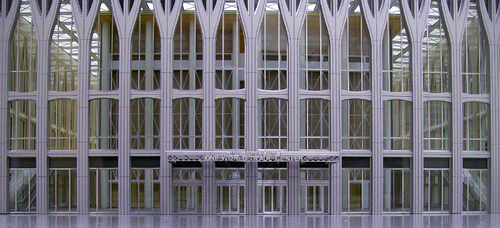
A model lobby from Twin Towers II
James writes:
As we mark the ninth anniversary of the September 11 attacks, the controversy of the Ground Zero Mosque has given rise to a conversation that should have occurred many years ago. Beyond question of the proposed Islamic community center’s proximity to Ground Zero, the debate has also brought to light several unanswered questions about the nature of Islam and its relation to terror: Given the radicalization of mosques and Islamic community centers in Europe, how do we know such meeting houses will not foment such behavior here? If the American Islamic community is immune to radicalization, what differentiates it from such communities in the Netherlands and France? How has the moderate American Muslim community reckoned with attacks carried out in the name of its faith? In sum: To what extent is Islam itself to blame in the extremism of the “Islamist” terrorists?
Following 9/11, a certain dogma of permissible rhetoric took hold that did not allow such questions to be answered or even to be asked. Criticize Islam and you recruit more terrorists. Have faith in moderate Islam and you destroy al-Qaeda. Maximal tolerance from us, it was thought, equals minimal hate from them.
A similar dogma took hold in the plans to rebuild Ground Zero itself. These beliefs quickly played out in the strong-arming of a sacred site by the ideologues of tolerance. Long before the attacks of 9/11, so-called enlightened urbanites bemoaned the outsize scale of the Twin Towers. They resented the superblock of the World Trade plaza for interrupting the street grid. The buildings, to them, were symbols of hubris. They objected to the same monumentality that the terrorists set out to destroy.
When an unelected claque of bureaucrats called the Lower Manhattan Development Corporation nominated itself to redesign the site immediately after the attacks, they sought to undo all of the wrongs of the people who had designed the original towers. They redrew and replaced the street grid, ensuring that the World Trade Center would not be reconstructed as it had been. They tapped a grief-mongering architect, Daniel Libeskind, to design the new buildings. They selected the falling water design of Michael Arad for the 9/11 memorial--when completed, a monument of negation that will aestheticize the sight and sound of the falling towers into a permanent replay of the attacks.
I used to assume that the redesigners of Ground Zero were oblivious to the symbolism of the site. But of course they were fully engaged in replacing the Twin Towers with a symbolism of their own: that of maximal tolerance. Thanks to them, they believed, no longer would the sins of the Twin Towers attract the ire of terrorists.
The problem with this approach is that it began with a dangerously untested premise--that maximal tolerance does indeed lead to minimal hate. But does the radicalized Islamic world capitulate to tolerance? Or is tolerance perceived as our own form of capitulation, engendering further attacks? Do we defeat Islamic terrorists by defending Islam--the conventional wisdom? Or would questioning Islam as does Ayaan Hirsi Ali break a code of silence that engenders radicalization? We never got the opportunity to ask.
So too with the designs for Ground Zero. Polls taken after the attacks of 9/11 showed that a majority of Americans wanted the Twin Towers rebuilt as they once stood. Meanwhile a team of architects independently submitted plans for new Twin Towers that could withstand future attacks. I regret that in 2002 we could not have engaged in the conversations we are having today. Had we I believe that Twin Towers II would have been built through popular mandate--because a vast majority of Americans understand their greatest defense is a strong offense. To rebuild the offending Twin Towers, stronger and taller, would have left us with a monument to unflinching national character, rather than a washbasin of grief.
The defenders of the “Ground Zero Mosque” have relished taking up the arguments of tolerance in advancing the community center. At least one prominent writer I have read wants a mosque moved inside the new World Trade complex itself. But this time a vocal majority, uneasy with the symbolism, I believe, of Ground Zero’s general redevelopment, has started to ask the unanswered questions. I regret this process did not begin in time to rebuild the Twin Towers. Yet on a tragic anniversary, I am still thankful for the new national conversation.